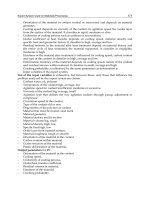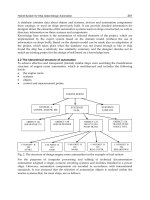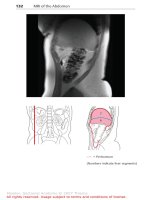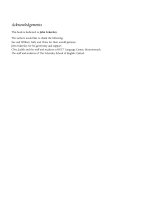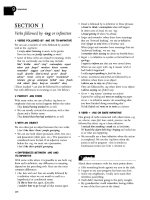POCKET GUIDE FOR CUTANEOUS MEDICINE AND SURGERY - PART 2 doc
Bạn đang xem bản rút gọn của tài liệu. Xem và tải ngay bản đầy đủ của tài liệu tại đây (379 KB, 26 trang )
P1: PJL
0521618134c01 CB1006/Lane 0 521 61813 4 November 26, 2005 21:56
Physical Examination 7
Anterior and medial legs L2–4
Foot L4, L5, S1
Medial great toe L5
Posterior and lateral legs L5, S1, S2
Lateral foot and small toe S1
Perineum S2–4
Anterior and superior helix Auriculotemporal nerve
Tragus Auriculotemporal nerve
Occipital scalp Greater occipital nerve
Posterior superior helix Lesser occipital nerve
Posterior inferior helix Greater auricular nerve
Posterior earlobe Greater auricular nerve
Neurology
Function
C5 abduct arm
C6–8 adduct arm
C5,6 flex elbow
C7,8 extend elbow; flex/extend fingers
C6 pronate/supinate
C6,7 flex/extend wrist
T1 abduct/adduct fingers
L1–3 flex, adduct, medially rotate hip
L3,4 extend knee
L4,5 dorsiflex, invert ankle
L5, S1 evert ankle
S1 plantar flex
P1: PJL
0521618134c01 CB1006/Lane 0 521 61813 4 November 26, 2005 21:56
8 Pocket Guide for Cutaneous Medicine and Surgery
Oculomotor exam
SR
SR
LR
MR
LR
IR
IR
SO
R eye
L eye
SO
IO
IO
CN III Superior division SR superior rectus
LA levator palpebrae superioris
Inferior division MR medial rectus
IO inferior oblique
IR inferior rectus
CN IV SO superior oblique
CN VI LR lateral rectus
P1: JPJ
0521618134c02 CB1006/Lane 0 521 61813 4 November 26, 2005 22:21
Anatomy
9
P1: JPJ
0521618134c02 CB1006/Lane 0 521 61813 4 November 26, 2005 22:21
10
P1: JPJ
0521618134c02 CB1006/Lane 0 521 61813 4 November 26, 2005 22:21
Anatomy – Trigeminal Nerve (CN V) – Facial
Sensory
Ophthalmic nerve (CN V1)
Lacrimal lateral upper eyelid, conjunctiva
Frontalis
Supraorbital anterior scalp, forehead, upper eyelids
(pierces frontalis to reach skin)
Supratrochlear medial upper eyelid, medial forehead,
anterior scalp, nasal root, nasal
bridge, upper nasal sidewalls (pierces
corrugator to reach skin)
Nasociliary
Infratrochlear medial upper eyelid, nasal root, medial
canthus, nasal bridge, upper nasal
sidewalls
Anterior ethmoidal
External nasal branch of anterior ethmoidal supplies
nasal dorsum, supratip, tip,
columella
Posterior ethmoidal
Maxillary nerve (CN V2)
Infraorbital lower eyelid, nasal sidewall, nasal
alae, upper lip, medial cheek,
columella, anterior nasal mucous
membrane (below infraorbital rim)
Zygomaticofacial malar eminence
Zygomaticotemporal preauricular cheek, anterior
temple/scalp
11
P1: JPJ
0521618134c02 CB1006/Lane 0 521 61813 4 November 26, 2005 22:21
12 Pocket Guide for Cutaneous Medicine and Surgery
Mandibular nerve (CN V3)
Auriculotemporal anterior/superior ear (helix, tragus,
temple, anterior half of external canal,
tympanic membrane), temporoparietal
scalp
Buccal buccal mucosa/gingivum, cheek
P1: JPJ
0521618134c02 CB1006/Lane 0 521 61813 4 November 26, 2005 22:21
Anatomy 13
Inferior alveolar
Mental chin, lower lip, lower lip mucosa, nearby
gingiva (exits mental foramen ∼2.5 cm
lateral to midline and inferior to 2nd
premolar)
P1: JPJ
0521618134c02 CB1006/Lane 0 521 61813 4 November 26, 2005 22:21
14 Pocket Guide for Cutaneous Medicine and Surgery
Anatomy – Facial Nerve (CN VII) – Facial Motor
Temporal
Innervates: frontalis, orbicularis oculi (with zygomatic
branch), corrugator supercilii,
temperoparietalis
Severed: ipsilateral brow ptosis and forehead paresis
Danger: as crosses mid-zygoma lateral to eyebrow
Zygomatic
Innervates: orbicularis oculi, procerus, nasalis, few mouth
elevators
Severed: inability to close eyelids
Danger: buccal fat pad covered by SMAS and risorius
Buccal
Innervates: depressor septi; nasalis levator superioris
alaeque nasi, levator labii superioris;
buccinator, risorius, mouth elevators,
zygomaticus major and minor; orbicularis
oris, levator angulis oris
Severed: food remains in cheek
Danger: buccal fat pad
Mandibular
Innervates: risorius; orbicularis oris; depressor anguli oris;
depressor labiii oris, levator anguli oris
Severed: drooping of ipsilateral lip and drooling
Danger: mandibular angle
P1: JPJ
0521618134c02 CB1006/Lane 0 521 61813 4 November 26, 2005 22:21
Anatomy 15
Cervical
Innervates: platysma and superior neck muscles
Severed: decreased retraction of lower lip inferolaterally
CN VII:
r
innervates all muscles of facial expression
r
enters skull via stylomastoid foramen
r
enters/traverses parotid gland
P1: JPJ
0521618134c02 CB1006/Lane 0 521 61813 4 November 26, 2005 22:21
16 Pocket Guide for Cutaneous Medicine and Surgery
Anatomy – Arteries of the Face
External carotid artery (supplies majority of face and scalp)
Facial artery (chief artery of the face)
Angular (supplies eyelids; joins ophthalmic artery)
Lateral nasal
Superior labial
Inferior labial
Superficial temporal artery
Frontal branch
Parietal branch
Zygomaticotemporal
Middle temporal
Transverse facial (anastomosis with branches of facial artery)
Occipital artery
Posterior auricular artery
Internal maxillary artery
Infraorbital
Buccal
Mental
Internal carotid artery
Ophthalmic artery
Supraorbital artery
Supratrochlear artery
Infratrochlear artery
Dorsal nasal artery
P1: JPJ
0521618134c02 CB1006/Lane 0 521 61813 4 November 26, 2005 22:21
Anatomy 17
P1: JPJ
0521618134c02 CB1006/Lane 0 521 61813 4 November 26, 2005 22:21
18 Pocket Guide for Cutaneous Medicine and Surgery
Anatomic Triangles of the Head and Neck
Anterior cervical triangle
Boundaries: anterior median line of neck
inferior border of mandible
anterior border of sternocleidomastoid muscle
Veins: internal jugular vein, retromandibular vein,
facial vein, superior thyroid vein
Arteries: superior thyroid artery, sternocleidomastoid
branch of occipital artery, facial artery
Nerves: greater auricular nerve, accessory nerve, facial
nerve (cervical branch)
Muscles: hyoid muscles:
suprahyoid: mylohyoid, geniohyoid, stylohyoid,
digastric
infrahyoid: sternohyoid, sternothyroid,
thyrohyoid, omohyoid)
Subdivisions of anterior cervical triangle:
Submental:
r
bounded inferiorly by body of hyoid bone and laterally by
anterior bellies of digastric muscles
r
contains submental lymph nodes and anterior jugular vein
Submandibular:
r
lies between inferior mandible and anterior/posterior
portions of digastric muscle
r
contains submandibular glands, submandibular lymph
nodes, hypoglossal nerve (CN XII), parts of facial
artery/vein
P1: JPJ
0521618134c02 CB1006/Lane 0 521 61813 4 November 26, 2005 22:21
Anatomy 19
Carotid:
r
bounded by superior belly of omohyoid, posterior belly of
digastric and anterior border of sternocleidomastoid
r
contains carotid artery, carotid sinus, carotid body, carotid
sheath
Muscular:
r
bounded by superior belly of omohyoid, anterior border of
sternocleidomastoid and median plane of neck
r
contains infrahyoid muscles, thyroid, parathyroid
r
contains submental lymph nodes, anterior jugular vein
P1: JPJ
0521618134c02 CB1006/Lane 0 521 61813 4 November 26, 2005 22:21
20 Pocket Guide for Cutaneous Medicine and Surgery
Posterior cervical triangle
Boundaries: posterior border of sternocleidomastoid
anterior border of trapezius
middle
1
/
3
of clavicle
Veins: external jugular vein, subclavian vein
Arteries: subclavian artery, suprascapular artery, occipital
artery
Nerves: spinal accessory nerve, lesser occipital nerve,
supraclavicular brachial plexus, greater
auricular nerve
Muscles: splenius capitus, levator scapulae, scalenus
medius, scalenus posterior
Subdivisions of posterior cervical triangle:
Occipital triangle: contains occipital artery in apex and
accessory nerve
Supraclavicular (subclavian) triangle: external jugular vein and
suprascapular artery located superficially, subclavian artery
located deep
Moore KL. Clinically oriented anatomy, 3
rd
ed. 1992, Williams and Wilkins,
Philadelphia, pp. 783–852.
P1: JPJ
0521618134c02 CB1006/Lane 0 521 61813 4 November 26, 2005 22:21
Anatomy 21
P1: JPJ
0521618134c02 CB1006/Lane 0 521 61813 4 November 26, 2005 22:21
22 Pocket Guide for Cutaneous Medicine and Surgery
P1: JPJ
0521618134c02 CB1006/Lane 0 521 61813 4 November 26, 2005 22:21
Anatomy 23
P1: JPJ
0521618134c02 CB1006/Lane 0 521 61813 4 November 26, 2005 22:21
24
P1: JZZ
0521618134c03 CB1006/Lane 0 521 61813 4 November 28, 2005 14:2
Dermatologic Surgery
25
P1: JZZ
0521618134c03 CB1006/Lane 0 521 61813 4 November 28, 2005 14:2
26
P1: JZZ
0521618134c03 CB1006/Lane 0 521 61813 4 November 28, 2005 14:2
Sutures
Absorbable: Absorption (days)
Surgical gut (fast-absorbing) 21–42
Surgical gut (plain) 70
Surgical gut (chromic) 70–90
Polyglytone 6211 (Caprosyn: Syneture) 56
Polyglactin-910 (Vicryl: Ethicon) 56–70
(Vicryl Rapide: Ethicon)
Lactomer (Polysorb: Syneture) 56–70
Polyglycolic acid (Dexon S/II: Syneture) 60–90
Glycomer 631 (Biosyn: Syneture) 90–110
Poliglecaprone 25 (Monocryl: Ethicon) 90–120
Polydioxanone (PDS II: Ethicon) 180
Polyglyconate (Maxon: Syneture) 180
Non-absorbable:
Silk (Perma-Hand: Ethicon; Sofsilk: Syneture)
Nylon (monofilament) (Ethilon: Ethicon; Monosof: Syneture)
Nylon (braided) (Nurulon: Ethicon; Surgilon: Syneture)
Polybutester (Novafil: Syneture)
Polypropylene (Prolene: Ethicon; Surgipro: Syneture)
Polyester (braided) (Mersilene: Ethicon; Dacron: Syneture)
(Teflon coated) (Ethibond: Ethicon; Ticron: Syneture)
Polyhexafluoropropylene-VDF (Pronova: Ethicon)
Weitzul S, Taylor RS. Suturing technique and other closure materials. In:
Robinson JK, Hanke CW, Sengelmann RD, Siegel DM., eds. Surgery of the
Skin. Philadelphia, Elsevier. 2005: pp. 227–230.
27
P1: JZZ
0521618134c03 CB1006/Lane 0 521 61813 4 November 28, 2005 14:2
28 Pocket Guide for Cutaneous Medicine and Surgery
Needles
Needle Curvature Length Syneture Ethicon
CC
1
3
/
8
11 mm PC-13 P-1
13 mm PC-10* PC-1*
16 mm PC-11* PC-3*
19 mm PC-12 PC-5
RC
2
3
/
8
11 m m P-10 P-1
13 mm P-13 P-3
16 mm P-11 PS-3
19 mm P-12* PS-2*
24 mm P-14 PS-1
1
/
2
9mm P-21 P-2***
13 mm P-22 PS-5
RC
2
1
/
2
15 mm P-24 PS-4
19 mm C-13** FS-2**
24 mm C-14 FS-1
1
CC = conventional cutting needle ()
2
RC = reverse cutting needle ()
∗
Representative facial cosmetic needles
∗∗
Representative biopsy needle
∗∗∗
Useful for vessel ligature in small anatomic locales (periorbital)
Weitzul S, Taylor RS. Suturing technique and other closure materials. In:
Robinson JK, Hanke CW, Sengelmann RD, Siegel DM., eds. Surgery of the
Skin. Philadelphia: Elsevier. 2005: pp. 230–232.
P1: JZZ
0521618134c03 CB1006/Lane 0 521 61813 4 November 28, 2005 14:2
Dermatologic Surgery 29
Electrosurgery
Electrocautery Not true electrosurgery
Heated filament transfers heat
No electric current transferred to patient
Useful with implantable cardiac devices
Monoterminal (1 contact between device & patient):
Electrodessication Electrode contacts tissue
Low amperage / high voltage
Dampened wave form
Electrofulguration Electrode above tissue (spark)
Low amperage / high voltage
Dampened wave form
Biterminal (2 contacts between device & patient):
Electrocoagulation Thermal coagulation
High amperage / low voltage
Dampened waveform
Electrosection Cuts through tissue
High amperage / low voltage
Undamped sinusoidal waveform
Soon S and Washington CV. Electrosurgery, electrocoagulation, electroful-
guration, electrodessication, electrosection, electrocautery. In: Robinson JK,
Hanke CW, Sengelmann RD, Siegel DM., eds. Surgery of the Skin. Philadel-
phia: Elsevier. 2005: p. 182.
P1: JZZ
0521618134c03 CB1006/Lane 0 521 61813 4 November 28, 2005 14:2
30 Pocket Guide for Cutaneous Medicine and Surgery
Antiseptic Cleansers
Chlorhexidine
(Hibiclens
TM
)
r
disrupts cell membranes
r
excellent gram-positive and good gram-negative coverage
r
intermediate onset (∼1 min. scrub)
r
ototoxicity and keratitis
r
residual chemical activity on skin
r
antimicrobial activity not affected by blood
Hexachlorophene (pHisoHex
TM
)
r
good gram-positive coverage only
r
can be absorbed through skin → neurotoxicity in infants
Iodine / Iodophores (Betadine)
r
iodine + surfactant → iodophore
r
oxidation/substitution by free iodide (active agent)
r
excellent gram-positive and good gram-negative coverage
r
intermediate onset
r
inactivated by blood and serum products
Isopropyl alcohol (70%)
r
denatures proteins
r
good gram-positive/negative coverage (mainly
gram-positive)
r
most rapid onset
r
caution with lasers (flammable)
Triclosan
r
disrupts cell wall
r
good gram-positive/negative coverage
r
intermediate onset
P1: JZZ
0521618134c03 CB1006/Lane 0 521 61813 4 November 28, 2005 14:2
Dermatologic Surgery 31
Occlusive Wound Dressings
Hydrogel
Description:
r
composed of polymer/copolymer and ≤95%
water
r
donates moisture to dehydrated tissue
r
absorbs some moisture of exudating wound
r
2 types: amorphous and sheet
r
non-particulate; non-toxic; non-adherent
Indications:
r
rehydrating sloughy/necrotic tissue
r
enhancing autolytic debridement
r
marked cooling effect; partial thickness
wounds
Application: apply cover with 2
◦
dressing (foam, film)
Limitations: may macerate wounds with high exudate
levels
Products: Solugel, Vigilon, Tegagel, Curagel, Clearsite
Hydrocolloid
Description:
r
suspension of gel-forming polymer
r
gums and adhesives on film/foam backing
r
promotes moist wound environment
r
aid autolytic debridement
r
no particulate/toxic components
r
waterproof and resistant to bacteria
r
impermeable to oxygen
Indications: lightly/moderately exudative wounds
Application: warm in hand prior to application to increase
activity of adhesive; no 2
◦
dressing needed;
wear 3–7 days

